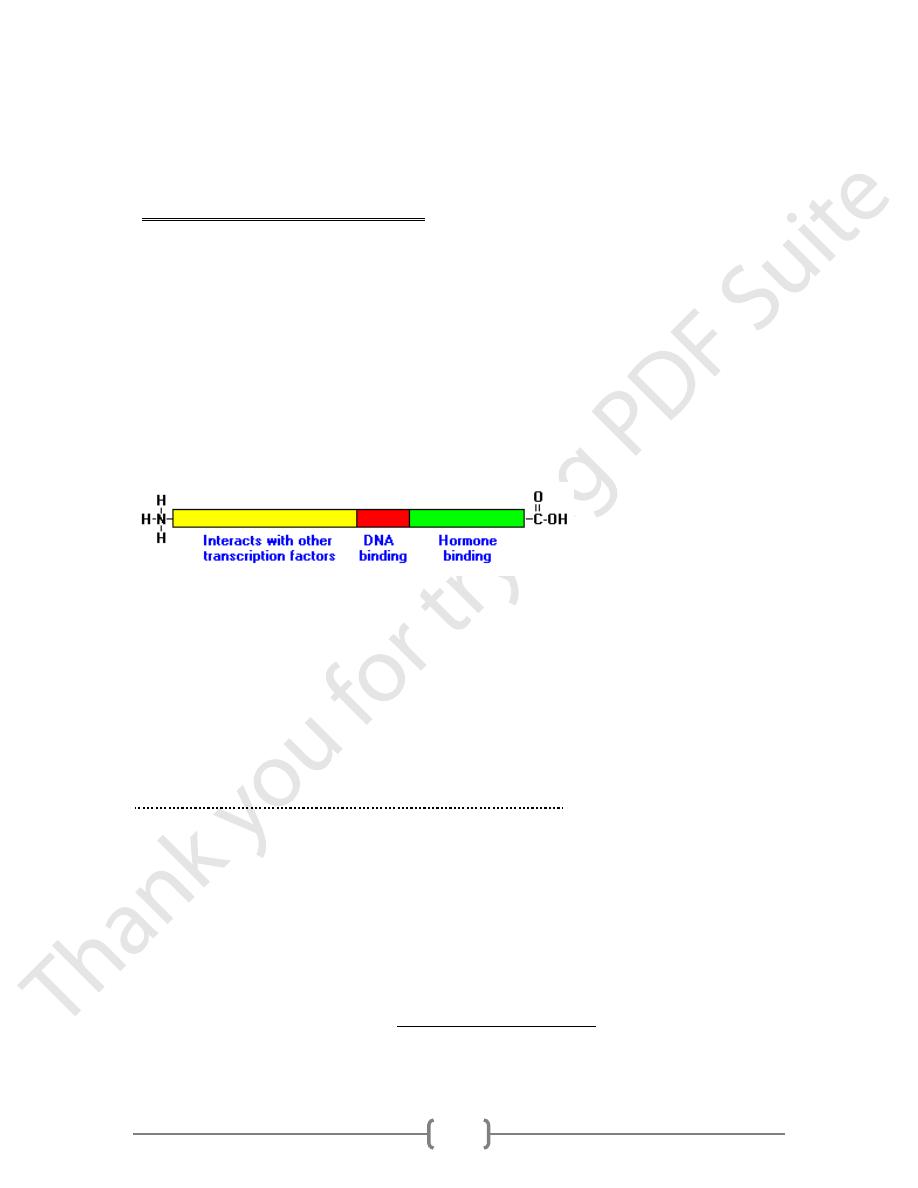
7
Lec.2 Mechanism of hormone action
Aim of the lec is to learn
The classification of hormones according to their solubility
The mechanism of action of each class of hormones.
Classification of hormones according to their solubility
Class 1 (Lipid soluble hormone) are characterized by:
• are lipophilic
• The free hormone, which is the biologically active form, can pass directly through the
plasma membrane of the target cells and bind to receptors .
• Their receptors are cytoplasmic or nuclear
• The hormone-receptor complex is the intracellular messenger in this group.
• Most act by activating DNA for protein synthesis
• travel through blood bound to proteins ,This helps them arrive at target tissues and
not diffuse prematurely out of blood into the wrong tissues Hormones bound to
globulins cannot be broken down, and are biologically inactive until released. Thus
bound they cannot trigger physiological responses, May function as a temporary
storage mechanism.
• Are slow acting and have longer half-life than peptide hormones
Examples: Thyroid hormones, steroid hormones as cortisol, estrogen ,testosterone and
vitamine D.
2. Class 2 hormones (Water soluble hormones)
Are hydrophilic.
bind to the receptors present on the plasma membrane of the target cell.
Hormones that bind to the surfaces of cells act through intermediary molecules called
second messengers (the hormone itself is the first messenger),
Include Polypeptides hormone and catecholamines
Mechanisms of hormone Action:
The chemical nature of the hormone also affects the mechanism of action. All hormones
act on cells by way of their 'receptors'. Each hormone has its own receptor to which it
binds. This is why hormones circulating throughout the body in the blood may leave
capillaries to enter the extracellular fluid of many tissues, but act only on those cells
which possess the appropriate receptor. Proteins and peptides cannot enter the cell and so
act via cell membrane receptors, producing their effects by 'second messengers', which
are activated in the cell as soon as the hormone binds to the receptor. Thus peptide
hormones can produce quite rapid responses. Steroid and thyroid hormones, by contrast,

8
can enter the cell and bind to intracellular receptors, producing their effects by
stimulating the production of new proteins. There is therefore a relatively long lag period
before the response to these hormones is seen
1. Hormones with Intracellular Receptors
Receptors for group I hormones (lipid soluble hormones: steroid and thyroid hormones)
are located inside the target cells, either in the cytoplasm or nucleus, and function as
ligand-dependent transcription factors. That is to say, the hormone-receptor complex
binds to promoter regions of responsive genes and stimulate or sometimes inhibit
transcription from those genes.
Thus, the mechanism of action of steroid hormones is to modulate gene expression in
target cells. By selectively affecting transcription from genes, then the concentration of
those respective proteins are altered.
Structure of Intracellular Receptors:
All of these receptors are composed of a single polypeptide chain that has, in the
simplest analysis, three distinct domains:
The carboxy-terminus or ligand-binding domain: This is the region that binds
hormone
DNA binding domain: Amino acids in this region are responsible for binding of
the receptor to specific sequences of DNA.
The amino-terminus: In most cases, this region is involved in activating or
stimulating transcription by interacting with other components of the
transcriptional machinery.
Hormone-Receptor Binding and Interactions with DNA
Being lipids, steroid hormones enter the cell by simple diffusion across the plasma
membrane. Thyroid hormones enter the cell by facilitated diffusion. The receptors exist
either in the cytoplasm or nucleus, which is where they meet the hormone. When
hormone binds to receptor, a characteristic series of events occurs:
Receptor activation is the term used to describe conformational changes in the
receptor induced by binding hormone. The major consequence of activation is that
the receptor becomes competent to bind DNA.
Activated receptors bind to "hormone response elements", which are short
specific sequences of DNA in specific genes.

9
Transcription from those genes to which the receptor is bound is affected. Most
commonly, receptor binding stimulates transcription. The hormone-receptor
complex thus function as a transcription factor
2. Hormones with Cell Surface Receptors
Include receptors for polypeptides and catacholamines hormones
Structure of Cell Surface Receptors
Cell surface receptors are integral membrane proteins and have regions that contribute to
three basic domains:
Extracellular domains: the part of the receptor that is outside of the cell interacts
with and binds the hormone - another term for these regions is the ligand-binding
domain.
Transmembrane domains: stretches of amino acids in the lipid bilayer of cell
membrane ,it insert the receptor in the membrane.
Cytoplasmic or intracellular domains: are part of the receptor that are within the
cytoplasm ,it interact with other molecules, leading to generation of second
messengers(which will be described below). Cytoplasmic part of the receptor are
thus the effector region of the receptor .
For the cell surface receptors binding of a hormone(ligand) to the receptor promotes a
conformational change in the receptor which transmits the information to the inner side
of the cell membrane. The conformational changes trigger a set of reactions termed
"Signal Transduction." Which is mediated by generation of second messengers within the
cell
second messengers :are molecules that transmit signals from receptors on the cell surface
to target molecules inside the cell, in the cytoplasm or nucleus, and cause some kind of
change in the activity of the cells ,they are activated or produced when the hormones bind
and activate the receptors.Second messengers activate intracellular enzymes and also
amplify signals. These second messengers are usually:
1. (cAMP) cyclic adenosine monophosphate molecules or
2. (cGMP) cyclic guanine monophosphatemolecules or
3. Ca
2+
or
4. protein kinase C (PKC).
The G-Protein-Coupled Receptors (example of cell surface receptor)
Are the largest family of cell-surface receptors it couple specific protein called G-proteins
to intracellular effector molecules.
G proteins also known as guanine nucleotide-binding proteins are a family of proteins
involved in transmitting chemical signals originating from outside a cell as aresult of
hormone binding to receptor called G protein-coupled receptors (GPCRs) into the inside

10
of the cell. G proteins function as molecular switches. When they bind GTP, they are 'on',
and, when they bind GDP, they are 'off'.
G proteins located within the cell are activated by G protein-coupled receptors (GPCRs),
hormones bind to a domain of the GPCR located outside the cell. An intracellular part of
GPCR then will activates a G protein. The G protein activates a cascade of further
signaling events that finally results in a change in cell function
for example activated G- protein binds and activates Adenylate cyclase, Adenylate
cyclase takes an ATP molecule and converts it to cAMP. cAMP is the second messenger,
which binds to protein kinase A (PKA). PKA can either phosphorylate cytosolic enzymes
, or it can go into the nucleus and phosphorylate the cyclic AMP response element
binding protein (CREB). This protein is already bound to the DNA. Phosphorylation of
CREB leads to its activation and promotes transcription.
ملخص
N Lipid-soluble Hormones
Water-soluble Hormones
1
lipophilic
hydrophilic
2
Bound to protein transporters when
circulate or transport through blood
(biologically inactive). The become active
when they separate from this bound
They are free & don’t need to bound to
proteins
3
Are slow acting & have half-life longer than
peptide hormones
Are rapid acting & have half-life shorter than
lipid-soluble hormones
4
Their receptors is either cytoplasmic or
nuclear (intracellular)
Their receptors are on the plasma membrane
& therefore, need 2
nd
messenger
5
The hormone receptor complex is the
intracellular messenger
The hormone itself is the 1
st
messenger
Intermediary molecules are 2
nd
messenger
6
Ex: steroid & thyroid hormones – vitamin D Ex: polypeptide hormones & catecholamines
7
Produce their effects by stimulating the
production of new proteins (by activating
DNA for protein synthesis) therefore,
produce actively long lag period before
response is seen
Produce their effects by 2
nd
messengers which
are activated in the cell as soon as the
hormone binds to receptor. Therefore, produce
quite rapid responses.
